Broken Hill > Adelaide and beyond
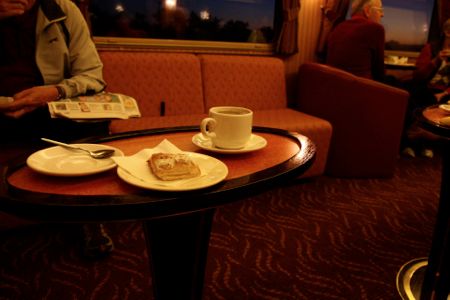
The body clock did its trick again and would have to be watched as we progressed westwards if I was going to avoid arising at some ungodly hour. In that regard, I mused as the consciousness kicked in, the Red Service may have been the better option as far as meal times go. Dinner after Adelaide was going to be late and if the diurnal rhythms were going to be maintained I suspected something would end up having to give.
That's the sort of thing you ponder when you're wide awake, the sun hasn't deigned to make an appearance and any attempt to sit up is going to cause a collision between your scone and the overhead bunk.
Still, as the time worked its way slowly towards sunrise, we had the prospect of an early morning tea. The train pulls into Broken Hill on the westward journey around six-forty CST, and we'd been warned to wind watches and other chronometric devices back half an hour before we retired for the night. I wasn't sure how to do this with the semi-flash new mobile phone, so I was still in EST when we arrived.
Since breakfast wasn't going to be served until after an 8:20 CST departure there was a 6:00 morning tea to provide sustenance to those who needed it. Plenty did, quite a few of them from the Red Sitting, which was understandable, but quite a few familiar faces from last night's dinner who may well have been sleeping in without the friendly reminder call over the P.A.
I got in two cups of remarkably decent coffee and Madam managed a cup of tea and a Danish as we learned that the temperature at Broken Hill was a rather crisp six degrees. Given the temperature, uncertainty about how to adjust the new mobile, and the fact that we were going to be there for two hours I would have been satisfied, assuming I was going outside at all, with a dingo's breakfast (a nervous pee and a quick look around) before retreating to relative warmth, but Madam needed a photographic record, some of which I would be able to use, so off we went, spending an hour roaming the streets, encountering a variety of fellow passengers and noting the locals were wisely tucked up somewhere warm.
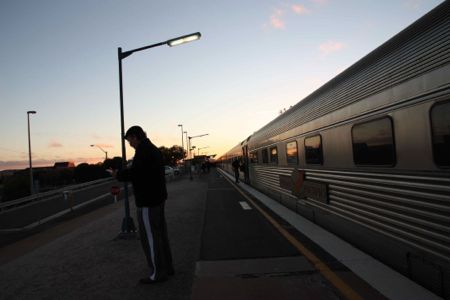
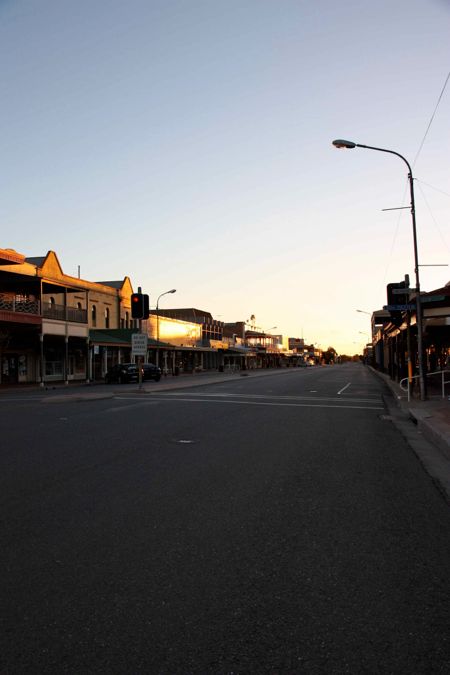
As far as Madam was concerned, the circuit could have been longer, but I managed to steer us back to the station comfortably before departure time.
While we’d been away the train crew had been engaged in a bit of cleaning up, and we returned to find a line of plastic bin liners arrayed along the platform. As we turned to board the train, something about one of them caught my eye, and I was mildly bemused to note that the bag closest to our door was emblazoned with a simple message: For Richard, the sort of thing that puzzles the inquiring mind.
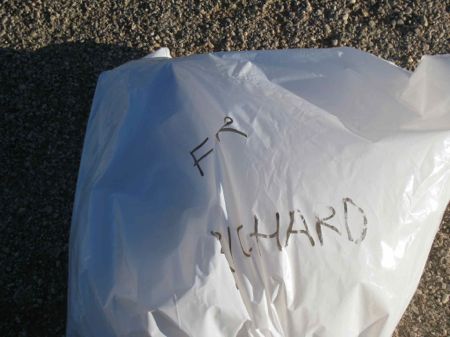
Who, I wondered, is Richard? What had he done to deserve this? What items of great significance were contained therein?
There are some things inquiring minds are better off not knowing, and I guessed that this was one of them.
Back aboard we had time for showers before we set off. After the initial encounter with the shower facilities this little black duck wasn't looking forward to the next, which I expected would take place in a moving train.

The space was limited, and we'd been warned to ensure that the shower curtain covered everything if we wanted to keep the water in the designated area. There weren't too many obvious places where the train was going to be stationary for any length of time after Adelaide apart from Cook, where the main purpose of the halt is to replenish the water supply at a cost of up to $2/litre!
Once we were moving again in full daylight the route took us across an ancient dry landscape covered with salt-bush and populated by the odd pocket of sheep, the occasional emu and, more than likely the obligatory kangaroo, though I didn't manage to spot one over the entire crossing. Still, it's hard to keep an eagle eye on the landscape and scribble notes at the same time.
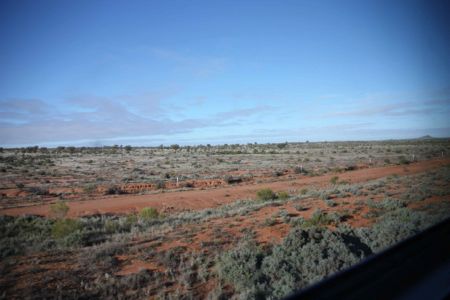
After Yunta, a surprisingly large settlement two hours out of Broken Hill the country started to improve, with stunted trees taking over from the salt-bush. There were signs of recent rain in the odd patch of greenery though for the most part the countryside looked like it'd soak up any precipitation when it hit the ground. In the unlikely event of summer rain (we're talking a Mediterranean climate in these parts) I suspected that rainfall would evaporate on impact.
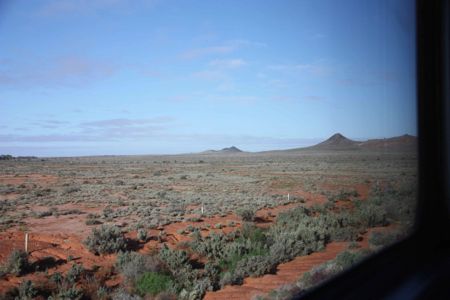
It's hard to tell where you are in a landscape without landmarks so I can't say where I spotted what may well have been an approaching shower. Our approach, however, differed, and we seemed to be skirting around any falling wetness. The scattered green pick on dry earth, however, suggested that we might have been a tad late and the extensive patches of significant erosion suggested that when moisture did condescend to condense, it took its share of dirt with it.
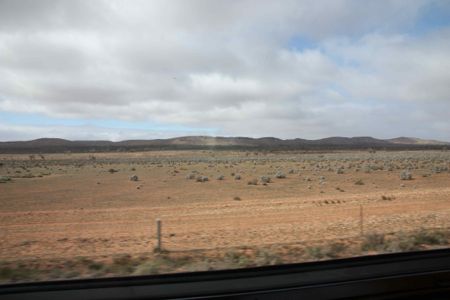
I spotted earth dams that were obviously man-made which, though dry as we passed, were obviously there to capture the runoff, along with a raised earth dam wall and evidence of something that looked a lot like contour ploughing or a near relative thereof, evidence that suggested the landscape, though largely bare at the moment, was being exploited. Presumably the exploitation involved grazing, and I wasn't sure where we were in relation to the Goyder Line. I noticed a homestead where the machinery included something that looked like a device used for cultivating the soil, though whether the item in question was a working device rather than a surviving relic of earlier endeavours was impossible to determine.
Crossing a bitumen road where the tarmac was still wet about ten minutes out of Peterborough it was obvious that we were into country that had, at some point in the recent past, been cultivated, and in some places the track-side reservoirs had already started filling with runoff.
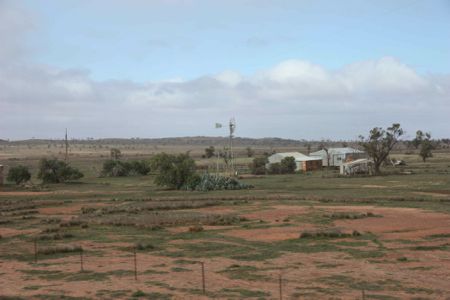
Peterborough itself marks one of three points in the area where three separate rail gauges meet. The first set of tracks to arrive was the railway from Port Pirie to Broken Hill, followed by the line linking Adelaide to Alice Springs by way of Quorn (the old Ghan) both of which were narrow gauge (3 feet 6 inch) lines. Before the launch of the Indian-Pacific, the line from Broken Hill was converted to standard gauge (4 feet 8 1⁄2 inch), and the line south of Peterborough to Terowie to broad gauge (5 feet 3 inch). You apparently get the same mix of gauges at Gladstone and Port Pirie.
While Peterborough must have been a thriving community back in the day it presented a much bleaker aspect through the contemporary mizzle. While the weather reduced visibility to a couple of hundred metres the landscape increasingly showed the benefits of recent rain and the agricultural side of things became increasingly obvious, with grain silos in substantial towns. Not substantial of populations running into the thousands, but somewhere more than a dozen or two in a township that boasted a roadhouse, a pub and something else.
The rain lifted as we passed what may have been Yongala (the town that gave its name to the steamer wrecked off the North Queensland coast) and Jamestown, birthplace of R. M. Williams, Sir Raphael Cilento and actor Paul Cronin.
Those two locations listed on the timetable but I assume the relevant stations were on the other side of the train. There was no other way of telling unless you managed to catch a glimpse of a place name on a pub, store or some other business that might choose to be place specific in its nomenclature. A glance in the Platform magazine suggested we weren't that far north of Clare.
An unexplained pause (usually we got an announcement and a potted history over the PA if we were stopping to let somebody on or off) wasn't all that long, but suggested that, within the basic limits it operates under, the timetable is relatively flexible, so from time to time if the train's running ahead of time it stops to let the timetable catch up.
I'd started on the trip under the belief that this was an express coast to coast enterprise, and once you were on you were on for the duration, but it was becoming increasingly obvious there weren't too many passenger services operating along the route, so there was an element of the milk run coming into things.
Under those circumstances (I'm guessing here and am therefore open to correction) a particular run might have no one to collect or deposit en route, while another might have a dozen. With a certain amount of time being lost at every pick up or set down, you're probably fine if the train's running late. On the other hand, if the train's running early, someone might miss it, so from time to time when they're running ahead of schedule they stop to allow the schedule to catch up, and I guessed that happened when they knew there was a pickup somewhere shortly down the line.
At least that's the conclusion I came to as I sat pondering why the heck we were stopping here.
After Gladstone the weather seemed to be lifting and there was a vista of green rolling hills across to the Clare-wards horizon and fields beside the track planted with peas or some other green manure type crop but was more than likely something else entirely.
Crop identification from a moving train isn't Hughesy's strong point.
Just before we were called for lunch we passed Snowtown of massacre fame, and the mention of the name brought a raised eyebrow from 'Er Busily Adding Photos To The Laptop (I was scribbling in the notebook). A long, relaxed and leisurely lunch (there are definite advantages in being in the second sitting) took us onto the Adelaide Plains with sightings of grape ins as the urban sprawl became increasingly obvious.
Back in the cabin to prepare for the three-hour spell in Adelaide we watched as the CBD high rise hove into view and I scanned the horizon for familiar structures as the train rolled into what was obviously the terminal with an increasing sense of unease, since Madam had lined up appointments with a couple of acquaintances from Adelaide days, and the first rendezvous point was at the station close to the CBD, which meant I should have been sighting the light towers from the Adelaide Oval over there, and I should be glimpsing the banks of the Torrens between them and the train.
Alighting, we discovered Adelaide's Parklands Terminal and Central Station are two different, discrete and completely unrelated kettles of fish. A $12 taxi fare took us to where we needed to be for the first rendezvous, and from there we set out in search of somewhere to sit and talk, something that wasn't 100% easy to find unless you were willing to shell out for something to eat and/or drink, something you're not likely to be over-enthusiastic shortly after a very good lunch and a late breakfast.
Madam managed a fruit juice and her friend something more substantial, but I was full up to the muzzle, and sat deleting some of the accumulated email and passing the occasional comment about the train trip, though there was no guarantee that any of my remarks actually coincided with the actual contents of the Japanese conversation.
As we headed for the second appointment, Madam's friend seemed nonplussed when I revealed that my grasp of the language comprises the equivalents of Hello, Good-bye, Thank You and Cheers.
Outside it was obvious that there'd been rain while we'd been inside. It had been raining steadily for the preceding couple of days and that the train's arrival had coincided with a brief break in the weather. Remembering that, we were probably stretching our luck a bit when the second rendezvous resulted in a decision to take a stroll along the banks of the Torrens, but the weather held off while we completed a circuit that brought us back to the new panda-motivated entrance to Adelaide Zoo.
By that time it was about the target I'd set for a taxi back to Parklands, where the sight of the terminal sans train would have had a drastic effect on the equanimity of those prone to panic attacks.
The explanation for the absence was fairly straightforward. Up to Adelaide, the train had been configured one way, and while we were off doing our Adelaide thing the carriages had been rearranged. To this point we'd been looking off to our left and looking towards the direction of travel. Now we were sitting with our backs to the engine, though the outlook was still to the left, which was now the northern side. It's obviously all done with mirrors.
At least the change meant that previously mentioned issues with the setting sun would now be a thing of the past, though that fat old Sol had well and truly gone to bed when the Indian Pacific rolled out of Adelaide.
With a number of new passengers on board I wasn't sure whether existing dinner arrangements would stand, and wasn't keen on being forced to switch to the early sitting, but no one came to discuss the matter, and when the Red sitting was called I set off for the Club Car with a view to seeing whether there'd be a chance of snaffling a free glass or two at the Blue Sitting Welcome Reception as well as the odd pre-prandial snifter.
That may seem uncommonly like freeloading, but once the glasses had been distributed, an inquiry from the new Hospitality Manager (they'd changed over in Adelaide) as to the makeup of the crowd in the Club Car revealed that newbies were rather thin on the ground.
Maybe that explained why there weren't any refills.
Dinner for the Blue Sitting wasn't due till nine, but I managed to kill the time in conversation with the couple we'd met over lunch (Madam was catching up on things in the cabin, with sleep a significant agenda item) and when I set off to advise dinner was on the horizon Gavin slipped a rather good bottle of Peter Lehmann Shiraz into the dinner mix.
As a result, while I wasn't quite walking on my knuckles when we toddled off to bed around eleven I didn't take much rocking.

